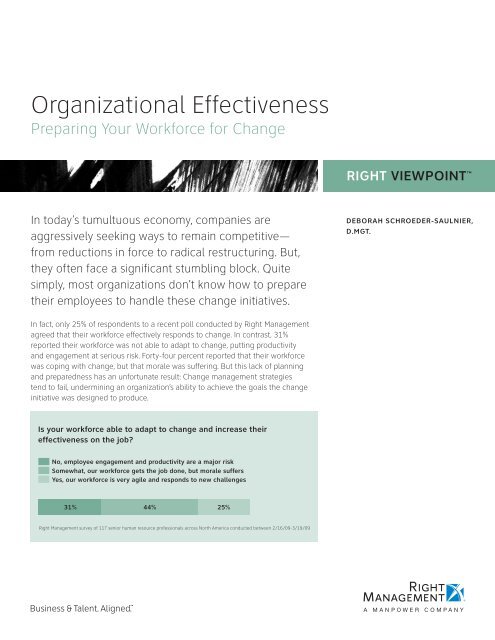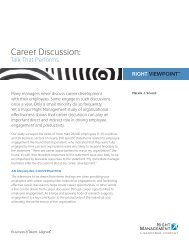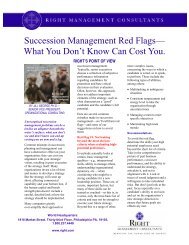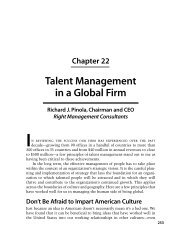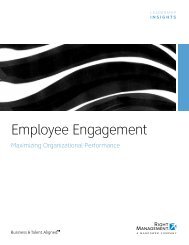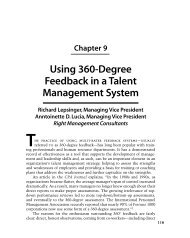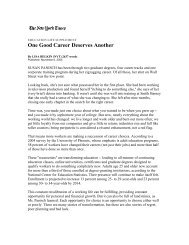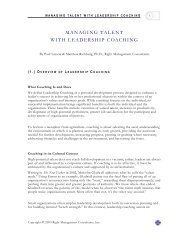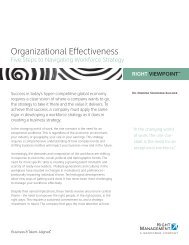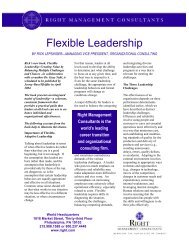Preparing Your Workforce for Change - Right Management
Preparing Your Workforce for Change - Right Management
Preparing Your Workforce for Change - Right Management
Create successful ePaper yourself
Turn your PDF publications into a flip-book with our unique Google optimized e-Paper software.
Organizational Effectiveness<br />
<strong>Preparing</strong> <strong>Your</strong> <strong>Work<strong>for</strong>ce</strong> <strong>for</strong> <strong>Change</strong><br />
In today’s tumultuous economy, companies are<br />
aggressively seeking ways to remain competitive—<br />
from reductions in <strong>for</strong>ce to radical restructuring. But,<br />
they often face a significant stumbling block. Quite<br />
simply, most organizations don’t know how to prepare<br />
their employees to handle these change initiatives.<br />
In fact, only 25% of respondents to a recent poll conducted by <strong>Right</strong> <strong>Management</strong><br />
agreed that their work<strong>for</strong>ce effectively responds to change. In contrast, 31%<br />
reported their work<strong>for</strong>ce was not able to adapt to change, putting productivity<br />
and engagement at serious risk. Forty-four percent reported that their work<strong>for</strong>ce<br />
was coping with change, but that morale was suffering. But this lack of planning<br />
and preparedness has an un<strong>for</strong>tunate result: <strong>Change</strong> management strategies<br />
tend to fail, undermining an organization’s ability to achieve the goals the change<br />
initiative was designed to produce.<br />
Is your work<strong>for</strong>ce able to adapt to change and increase their<br />
effectiveness on the job?<br />
No, employee engagement and productivity are a major risk<br />
Somewhat, our work<strong>for</strong>ce gets the job done, but morale suffers<br />
Yes, our work<strong>for</strong>ce is very agile and responds to new challenges<br />
31%<br />
44%<br />
<strong>Right</strong> <strong>Management</strong> survey of 117 senior human resource professionals across North America conducted between 2/16/09-3/19/09<br />
25%<br />
RIGHT VIEWPOINT <br />
DEbORaH ScHROEDER-SaulNIER,<br />
D.MGT.
<strong>Change</strong> ManageMent that works<br />
It doesn’t have to be that way. In fact, companies that understand the inextricable<br />
connection between preparing employees to accept change and effective<br />
implementation of new initiatives are likely to see their ef<strong>for</strong>ts succeed. With careful<br />
planning and the support of top leaders, organizations can help their work<strong>for</strong>ces<br />
adapt to change—and the business retain its competitive edge.<br />
Failure to act can have severe consequences. According to a recent survey by<br />
Leadership IQ of workers who remained at their employers after a downsizing,<br />
74% of respondents said productivity declined and 69% felt the quality of the<br />
company’s product or service had dropped. In fact, when managers and employees<br />
are unwilling to embrace change, the result can be everything from high turnover<br />
and absenteeism to decreases in employee engagement, per<strong>for</strong>mance, productivity,<br />
brand reputation and customer loyalty. And that, of course, ultimately impacts<br />
the bottom line.<br />
Why do change management strategies tend to fail? For one thing, there’s the<br />
matter of human nature: Most people have a hard time dealing with change.<br />
But, more than that, they lack specific behavior traits needed to adapt easily to<br />
difficult changing circumstances. Consider the results of an assessment instrument<br />
used by <strong>Right</strong> <strong>Management</strong>. It evaluates an individual’s ability to effectively deal<br />
with change by analyzing a number of key traits—such factors as an ability to<br />
remain calm even in stressful situations and to reach mutually beneficial outcomes<br />
during a time of change. See sidebar “Assessing <strong>Change</strong> Readiness.”<br />
In addition, there are important organizational reasons <strong>for</strong> these failures. Many<br />
companies don’t understand the importance of change management nor do they<br />
regard it as a core competency <strong>for</strong> leaders. As a result, they fail to provide adequate<br />
development, thereby crippling a manager’s ability to lead during times of change.<br />
When companies do provide development, they tend to rely on isolated workshops<br />
lacking a real organizational or business context, with little follow-up and few<br />
practical lessons that are likely to stick.<br />
2
3<br />
aSSESSING cHaNGE REaDINESS<br />
<strong>Right</strong> <strong>Management</strong>’s change effectiveness assessment predicts an<br />
employee’s likely response to change. Based on the results of 5,000<br />
assessments, we looked at the most common responses to change and<br />
grouped results into three categories: Concern, Moderate and Strength.<br />
change Effectiveness behavior<br />
adaptability<br />
Self assurance<br />
Reaching agreement<br />
building Relationships<br />
Influence<br />
Perseverence<br />
concern<br />
Strength<br />
Respondents<br />
The implication <strong>for</strong> organizations is that nearly half of all employees will<br />
struggle with being open to change—which is being tested to extreme<br />
measures with the economic uncertainty we are currently facing—creating<br />
multiple barriers to impede the success of the change initiative.<br />
The good news is that 48% of respondents fall into the Strength category <strong>for</strong><br />
Building Relationships. Collaboration, team work and collegiality are critical to<br />
achieving goals. Identifying individuals that know how to interact appropriately<br />
with others and build and maintain interpersonal relationships will be an<br />
important part of ensuring success in your change initiative. This is particularly<br />
essential <strong>for</strong> those who need to lead changes in their organizations.<br />
38%<br />
43%<br />
44%<br />
48%<br />
31%<br />
22%
a strategY For eFFeCtIVe <strong>Change</strong><br />
Putting in place a successful change management strategy is not an easy<br />
undertaking. It requires putting in place an integrated planning process, including<br />
steps to take be<strong>for</strong>e, during and after the change. While what you do to prepare<br />
be<strong>for</strong>ehand is critical, the actions you take while implementing the change and<br />
afterwards are also very important. Following this multi-step process can put you<br />
on a path to realizing the benefits your organization needs to achieve through the<br />
change initiatives it is undertaking.<br />
BeFore<br />
1. understand previous change initiatives.<br />
To create an effective plan, you need to know what happened during earlier change<br />
initiatives. That means working with leaders and employees to learn what worked,<br />
what didn’t and what gaps need to be filled.<br />
2. Involve top leadership.<br />
For best success, it is imperative that senior leaders, including the CEO, are<br />
clearly behind the ef<strong>for</strong>t. Indeed, leaders need to drive change throughout the<br />
organization. To that end, HR practitioners have to demonstrate to executives that<br />
change management isn’t a “nice-to-have,” but a necessity to ensure that the talent<br />
management strategy is aligned with the business strategy.<br />
3. Identify people who might be potential stumbling blocks or champions.<br />
Part of that process can involve using an assessment to help individuals understand<br />
their strengths and weaknesses. You might also ask employees to share the findings<br />
with their manager, who can help build an awareness of how they react during<br />
times of change. The manager can also use the results to create a team profile and<br />
discuss how individual behaviors might affect the group dynamic. In the process,<br />
they can also refer to the assessment to create a common language <strong>for</strong> discussing<br />
how to deal with change.<br />
4. Map out a change process.<br />
Most important is pinpointing the key areas in which employees are likely to<br />
be affected—anything from a new per<strong>for</strong>mance management system to a<br />
reorganization of teams—and then putting in place appropriate initiatives to help<br />
them adapt to the changes. You may also consider restructuring the reward system<br />
to rein<strong>for</strong>ce certain behaviors.<br />
5. construct an effective communications system.<br />
You have to communicate your vision and plan convincingly throughout<br />
the organization. That means building it into everything you do, from your<br />
per<strong>for</strong>mance management system to regular intranet postings.<br />
4
DurIng anD aFter<br />
6. Provide adequate support and development <strong>for</strong> line managers to lead<br />
employees through the change.<br />
That may take the <strong>for</strong>m of group or one-on-one interactions, depending on the<br />
circumstances. In some cases, it’s helpful to bring managers together, because the<br />
process of dealing with change can be an isolating experience. At the same time,<br />
managers should hold individual meetings with each team member.<br />
7. Provide coaching <strong>for</strong> managers who still need help.<br />
Provide adequate support and development to managers to help drive change<br />
through the organization. If they are unable to effectively communicate the vision<br />
and strategy and engage the team through the process, the change initiative will<br />
not succeed. Managers need to provide role clarity and ensure employees are<br />
aligned with the new strategy in order to meet per<strong>for</strong>mance objectives and<br />
achieve goals.<br />
8. Measure success.<br />
Define success at the outset and the metrics to be used to assess whether you’ve<br />
achieved your goals and objectives. For example, in some cases, you may need to<br />
measure a manager’s ability to have an effective conversation with an employee<br />
about change. Under those circumstances, it might be appropriate to ask his or her<br />
direct reports to do a 360° evaluation of their interactions. On the other hand, if<br />
success is defined as how the organization as a whole manages change, then you<br />
might ask employees to fill out opinion surveys be<strong>for</strong>e and after the change initiative.<br />
reCoMMenDatIons<br />
An effective change management process can’t be an afterthought. Indeed, it<br />
requires a comprehensive ef<strong>for</strong>t involving all levels of the organization, driven by<br />
top management. But companies have no choice. <strong>Change</strong> is a constant. In order<br />
to succeed and thrive in today’s rapid-paced and tumultuous market, organizations<br />
need an agile work<strong>for</strong>ce that can effectively respond to, adapt to and per<strong>for</strong>m<br />
under these conditions. Develop a plan with measurable goals. Identify and develop<br />
effective change management behaviors within the work<strong>for</strong>ce. Carefully implement<br />
a process that includes leadership support, development, effective communication<br />
and success measures. By following these steps, your organization’s work<strong>for</strong>ce<br />
will have the agility needed to meet the high demands of the change initiative,<br />
per<strong>for</strong>ming at the levels you need to ensure the company remains competitive and<br />
achieves its strategic goals—even in today’s tough economy.<br />
5
6<br />
caSE STuDY<br />
Provide a Two-Tiered Process<br />
<strong>for</strong> Employees and Managers<br />
For best success, an effective change management strategy should<br />
take a two-tiered approach. Consider the experience of a global<br />
leader in the office furniture industry. To retain its industry leader<br />
position, the organization had to increase world-wide growth<br />
initiatives, while maintaining its sales and profitability levels. Achieving<br />
that required a major change strategy, including new streamlined<br />
manufacturing, technology and personnel processes, and the<br />
elimination of operational silos. Success could only be achieved with<br />
the participation of a fully-engaged work<strong>for</strong>ce.<br />
Working with <strong>Right</strong> <strong>Management</strong> the company designed an<br />
integrated, two-part process aimed at employees and managers.<br />
The employee program showed individuals how to navigate change<br />
successfully and manage their careers using <strong>Right</strong> <strong>Management</strong>’s<br />
change readiness assessment and other tools. Managers (who were<br />
in the midst of adapting to the change themselves) developed<br />
essential change leadership skills and learned to hold career decision<br />
conversations with their direct reports.<br />
Results as shown in a pre- and post-program survey:<br />
Managers Ready to lead<br />
change<br />
Employee confidence level in<br />
ability to adapt to change<br />
Employee confidence level<br />
in ability to Determine Short-<br />
and long-term career Plans<br />
be<strong>for</strong>e<br />
59%<br />
52%<br />
53%<br />
after<br />
94%<br />
94%<br />
90%<br />
Variance<br />
+59%<br />
+80%<br />
+70%<br />
about the author<br />
Dr. Deborah Schroeder-Saulnier is Senior<br />
Vice President <strong>for</strong> <strong>Right</strong> <strong>Management</strong>’s<br />
Global Solutions Team with responsibility<br />
<strong>for</strong> overseeing the firm’s Organizational<br />
Effectiveness and Employee Engagement<br />
solutions portfolio – focused on aligning<br />
talent management strategy with<br />
business strategy.<br />
about <strong>Right</strong> <strong>Management</strong><br />
<strong>Right</strong> <strong>Management</strong> (www.right.com) is<br />
the talent and career management expert<br />
within Manpower, the global leader in<br />
employment services. <strong>Right</strong> <strong>Management</strong><br />
helps clients win in the changing world of<br />
work by designing and executing work<strong>for</strong>ce<br />
solutions that align talent strategy<br />
with business strategy. Our expertise spans<br />
Talent Assessment, Leader Development,<br />
Organizational Effectiveness, Employee<br />
Engagement, and <strong>Work<strong>for</strong>ce</strong> Transition<br />
and Outplacement. With offices in over 50<br />
countries, <strong>Right</strong> <strong>Management</strong> partners with<br />
companies of all sizes. More than 80% of<br />
Fortune 500 companies are currently<br />
working with us to help them grow talent,<br />
reduce costs and accelerate per<strong>for</strong>mance.<br />
© <strong>Right</strong> <strong>Management</strong> 2009.<br />
All <strong>Right</strong>s Reserved.<br />
www.right.com 1.800.237.4448


